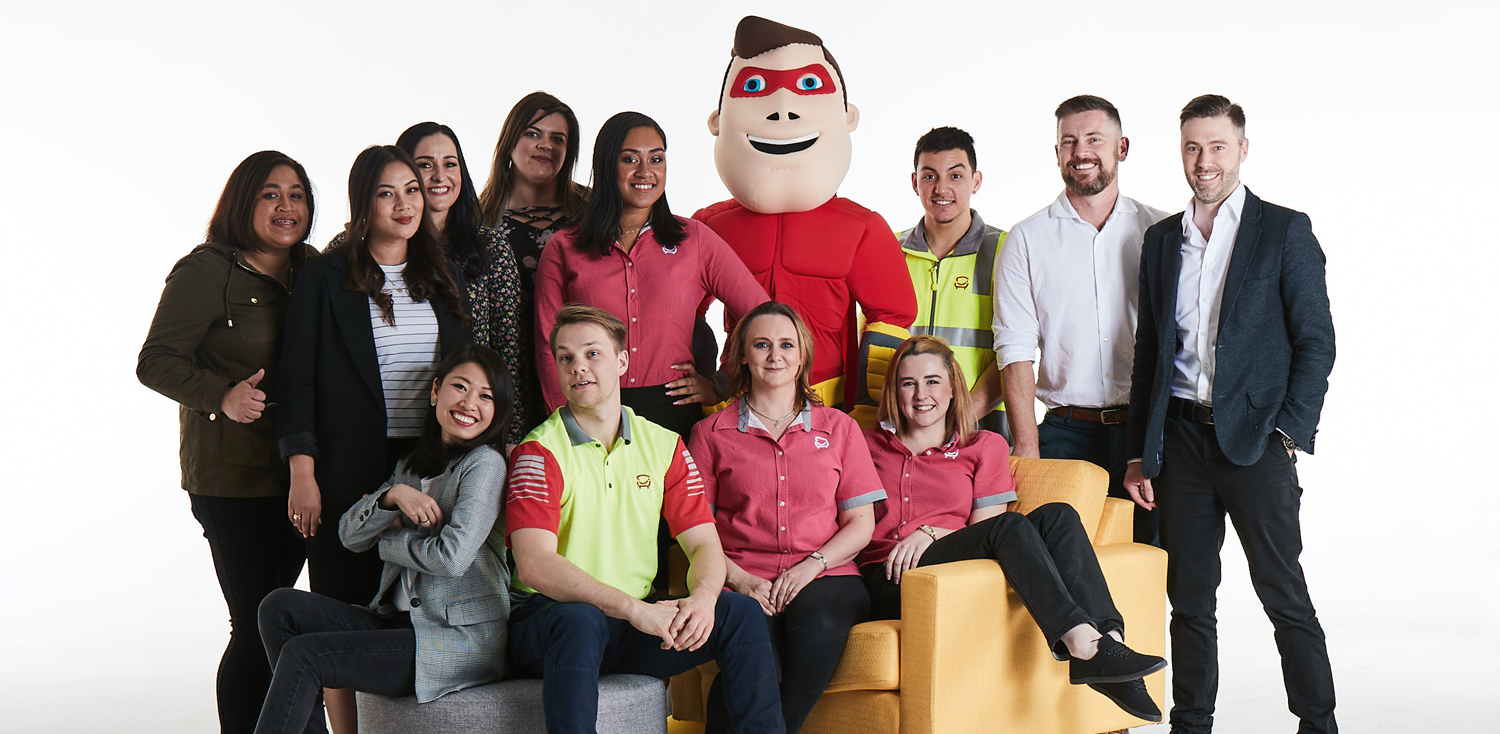Professional learning doesn’t have to be dull. Rewrite the rules and you’ll have happy, engaged team members that stick around, says learning and development specialist Samantha Mueller.
By Emma Mulholland
Anyone who has worked in retail knows the biggest challenge is attracting and retaining talent. That’s where Samantha Mueller, Head of Learning and Development at Fantastic Furniture comes in. Her secret? Delivering a fantastic experience from day one onwards. If you can delight team members from the start you’ll have skilled, engaged team members that want to stay and progress in the business. Since she joined the well-known retailer Fantastic Furniture in 2016, Mueller has focused on delivering learning solutions that are aligned to the business objectives and mission to ‘Make Life Fantastic’.
“I love the brand – it’s a fun, vibrant and dynamic place to be,” she says of the company, which has come a long way in its 30 years. What started out as a single stall selling plastic garden furniture at Sydney’s Parklea Markets now comprises 75 stores, two Australian manufacturing factories and more than 1,200 employees.
A brand refresh in March has played up the company’s fun, cheeky approach to the market and has brought significant changes, including plans to grow the business and a refresh of its employer brand and values. But what could have been a challenging time for the team and business has instead been an opportunity to engage and innovate? Here, the Head of Fantastic Furniture’s Learning and Development team tells Leadership Matters how they pulled it off.
Collaborative approach
“I’m collaborative in my approach — I look for ways to involve others and leverage the diverse experience of our team,” says Mueller, who started at the Sydney office after stints at Dick Smith Electronics and international beverage behemoth Lion. “My background is in leading operational
teams but over time I’ve morphed into L&D roles. I’ve always been passionate about L&D because of the positive impact it can give individuals and the business. I’ve seen the impact when L&D is not a priority – it has a negative impact on engagement, turnover and growth.”
Investment in roles like Mueller’s are becoming increasingly common in the retail sector — a shift she puts down to the modern workplace, where employees are after more than just a pay cheque. “Just like customers, who want more value and a better experience from retailers, our people want more from us too: more input, more opportunities and a greater employee experience,” she says. “Businesses that aren’t focused on that are the ones that get left behind.” But strong engagement brings its own challenges.
In the case of Fantastic Furniture, where team members are encouraged to take ownership of the brand, any organisational change involves collaboration with the team.
“The brand refresh was not about changing direction but showcasing who we are and what we stand for,” says Mueller. “Our teams are extremely passionate about the business, so the change management approach was critical. We took every opportunity to seek input on decisions that impact the team. For example our marketing team flew retail team members to Sydney so they could be part of designing their new uniforms. Taking this collaborative approach enabled the team to prepare for change and contribute to outcomes that impact them.”
Learning that benefits team member and the business
Before embarking on a new project, Mueller asks herself one question: how will this make life fantastic for the team and business? “With the rebrand, we reviewed our L&D programs to align core programs to business objectives. In the past two years we’ve rebuilt our induction and foundation programs with an emphasis on ensuring our team has a fantastic experience through every touch point.
“We launched our accredited training through ‘Fantastic eCademy’, enabling team members to complete their Certificate III in Retail and progress their careers within our business. We’ve also enhanced our online platform ‘Learning Lounge’ to improve how we communicate and deliver learning on a national scale. We’re focused on delivering solutions that benefit both team members and the business,” says Mueller.
Mueller’s team recently revamped the online (World Manager) platform which is accessible to team members via desktop and a smartphone app. The online platform is used to deliver learning and communications, as well as manage a peer recognition program. They’ve also created social forums for team members to share updates and provide feedback. “We’re leveraging technology to enhance the learning experience,” says Mueller. “For me it’s about creating something that our team want to participate in and be part of.”
Experience is everything
When in doubt, Mueller asks herself: “How will this create a fantastic experience?” For example, during a review of Fantastic Furniture’s customer service training, she let the retail teams take the reins, asking them: “How can we deliver a great experience for customers?” In the end, they came up with a ‘Fantastic Customer Experience Program’ that involves a unique six-step approach.
To launch the program, the regional area leaders came up with a competition, ‘Share your Fantastic Customer Experiences’. Team members were encouraged to post on an online forum about the fantastic experiences they were delivering to their customers. “Team members immediately began posting videos, sharing success stories, singing and acting out the Fantastic six process for engaging customers,” says Mueller. “The results were amazing. We got the highest usage and click throughs we’ve ever had on the forums and two months following the launch, Fantastic Furniture recorded its highest-ever net promoter score (NPS). Customers are having a fantastic experience in stores and NPS results are continuing to increase”. The benefits are ongoing. Engagement and posts on the forums have continued and the social sharing aspect has proven to enhance the teams learning experience.
Fantastic Beginnings
Mueller says that a fantastic onboarding and induction is one that is structured, personalised and well supported: “First impressions count and we’ve found that our ‘Fantastic Beginnings’ program helps new starters get up and running quickly because they know what to expect and what path they’ll follow in their first three months.”
On day one, new starters receive a Fantastic Welcome Pack, customised by their leader, which includes a guide to help them navigate their first three months. The leader also has a guide to support them with the onboarding and induction process.
“I’m a big believer in a blended approach so we’ve incorporated online learning with on-the-job activities and check-ins along the way,” says Mueller. “We utilise our platform to capture how people are tracking.” From there, the team member and leader have regular check-ins, so they have a chance to connect, share feedback and set goals.
Pathways to progress
When Mueller surveyed team members to find out what they wanted from L&D, one thing stood out: opportunities to learn and progress. And so the Fantastic eCademy was born: a nationally accredited, nine-month program. Over the past 12 months, 100 team members have completed the program, attaining a Certificate III in Retail. “What’s great is that our leaders, including CEO Debra Singh, get involved in the graduations and make a big effort to recognise the achievements of our team,” says Mueller. “Demand is such that over the next year we will look at adding higher qualifications to the mix, including Certificate IV or Diploma level qualifications.”
A clear organisational pathway makes it easy for employees to know what skills and behaviours will assist them in progressing to their next role. Recently Mueller, launched the ‘Fantastic Leadership Pathway’. The pathway has four defined levels of leadership – from The Ace (high potential team members and first-time leaders) through to The Visionary (those at general manager and executive level) – each level is identified by a particular set of skills and behaviours.
Team members are encouraged to take a proactive approach with their development and are supported with an online toolkit. The toolkit contains training resources and links to external sources, including leadership books such as Georgia Murch’s Fixing Feedback. “Two months after the launch we had more than 500 downloads, which is significant because it shows that both leaders and team members are proactively using it,” says Mueller.
“I’ve just launched ‘ACE Leadership’, our first national leadership program aligned to the leadership pathway. It’s a six-month program designed to support new leaders to raise their profile and take ownership of their personal brand. We’ve had more than 130 ACE leaders enrol in the program. I’m excited to support their journey and progression in our business.”
Measuring success
Mueller’s team will evaluate the leadership program over the coming year, assessing the participants’ career progression and the take-up among the company’s high-potential team members. Every project her team launches is evaluated to assess if intended outcomes have been met. Mueller’s team is fun and down to earth but also commercially focused. “It’s important to be able to demonstrate the value L&D adds to the business,” she says.
“We always look at the return on engagement and investment. For example, with our Customer Experience Program, we looked at participation and leader feedback, as well as our NPS, sales and upsells. We compared results before and after the program.”
Since Mueller joined Fantastic Furniture, employee retention has increased 14 per cent. When asked what makes her such an engaged member of the Fantastic Furniture team, Mueller doesn’t hesitate: “What really stands out for me is the genuine care, commitment and investment in people. I’m supported and empowered to deliver on our mission to Make Life Fantastic”.











